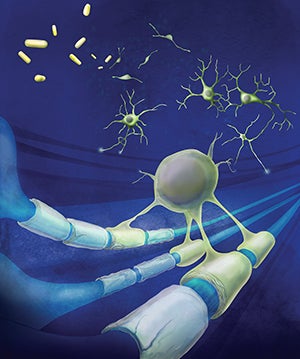launch
RESEARCH BREAKTHROUGH
 Artwork by Megan Kern
Two FDA approved drugs were found to stimulate stem cells in the brain and spinal cord to regenerate to the protective coating around neurons that is damaged in diseases such as multiple sclerosis.
Artwork by Megan Kern
Two FDA approved drugs were found to stimulate stem cells in the brain and spinal cord to regenerate to the protective coating around neurons that is damaged in diseases such as multiple sclerosis.
A pair of topical medicines already alleviating skin conditions each may prove to have another, even more compelling use: instructing stem cells in the brain to reverse damage caused by multiple sclerosis (MS).
Led by researchers at Case Western Reserve, a multi-institutional team identified the two most promising medications—one that treats athlete's foot, and the other, eczema—and then tested them further. As detailed in the April 20 online edition of Nature, the drugs yielded dramatic results in animal models and human cells.
"We know that there are stem cells throughout the adult nervous system that are capable of repairing the damage caused by MS, but until now we had no way to direct them to act," said Paul Tesar, PhD (CWR '03), the Dr. Donald and Ruth Weber Goodman Professor of Innovative Therapeutics and associate professor in the Department of Genetics and Genome Sciences at Case Western Reserve School of Medicine. "Our approach was to find drugs that could catalyze the body's own stem cells to replace the cells lost in MS."
The findings mark the most promising developments to date in efforts to help the millions of people around the world who suffer from MS. The disease is the most common chronic neurological disorder among young adults. It results from aberrant immune cells destroying the protective coating, called myelin, around nerve cells in the brain and spinal cord.
This breakthrough only became possible because of a 2011 discovery from Tesar's lab—specifically, the development of a unique process to create massive quantities of a special type of stem cell called an oligodendrocyte progenitor cell (OPC). These cells are normally found throughout the adult brain and spinal cord and therefore are inaccessible to study. But once Tesar's team could produce billions of the OPCs with relative ease, they could test hundreds of potential medications. Researchers looked at 727 compounds in all, then tested the two most promising—miconazole and clobetasol—on mice afflicted with an MS-like disease.
Both drugs prompted native OPCs to regenerate new myelin, and the animals' symptoms began to abate. When subsequently tested on human cells in the lab, the drugs again prompted OPCs to make myelin. Scientists' next steps are to learn more about how the medicines prompt the OPCs to act and then develop new formulations for potential human use.
Tesar, a New York Stem Cell Foundation Robertson Investigator and member of the National Center for Regenerative Medicine, led a collaboration including nearly a dozen researchers from Case Western Reserve as well as additional scientists from the medical sciences company PerkinElmer, the National Institutes of Health, Northwestern University and the University of Cincinnati.






